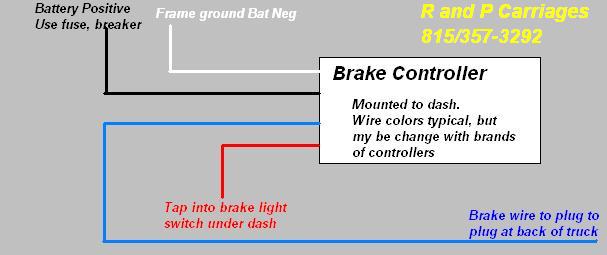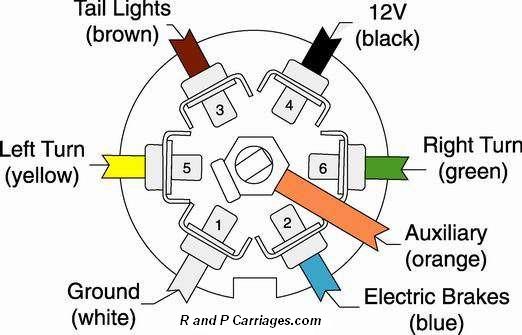Read and follow the instructions that came with your controller, The following information will help make the instructions "make sense".
Concept:
Electric Trailer Brake Controllers supply a variable voltage from the truck, from 0 to 12 volts, to the trailer brakes. More voltage, greater stopping power. The brake controller varies the voltage to the trailer to allow for brake modulation. Without the controller, the brakes would get full 12 volts and the trailer tires would lock up, every time.
Types of Controllers.
Basically you have two types: Time and Inertia:
Time is really just like a dimmer switch in your house. You "turn it up" and when you hit the brakes, it supplies a pre-set voltage to the trailer. Every time. If you set it to "half way" it will give 6 volts to the trailer every time you hit the brakes. Turn it up or down, and you get more or less. Simple to use, and install. But, in a panic stop, you still get only that 6 volts you had it set at. In stop and go traffic, you get that same jerky brake setting. So, you set it for strong braking, and you will find you are stopping BEFORE the intersection. Too light a setting, and you blow through the stop sign. I would say this is for the person that rarely pulls a trailer, and is looking for simple.
Inertia types have a sensor (usually a pendulum) that senses how hard you are tying to stop, and increases voltage to the trailer the harder you stop the truck. This is better design, but typically must be "leveled" to operate correctly (the pendulum) . Some of the cheaper models are sensitive to road bumps while braking, and can get jerky. The better Models offer self leveling, and gyroscope sensing electronics that compensate for all directions of movement, and offer truly seamless trailer braking. I personally sell both types, with the Tekonsha Prodigy being my best controller.
Hooking up the controller:
Trucks, cars and vans vary allot! The factories intended many vehicles to pull trailers, (hint, they installed the factory tow package) so they may have much of the wire you need already installed. Have a look under your dash, under the hood, in the owners manual, and call your dealer.
The brake controller normally has 4 wires to connect. I have used the colors used on Tekonsha Controllers. I find most makers use the same colors, but the function is what is important, not the color, so check yours first! The heavy gauge Blue wire is ALWAYS the wire to the back of the truck, to the trailer brakes:
Wire 1: (red)
The "trick" is finding the brake light switch 12 volt feed. You must find the wire from the brake switch under the dash that comes on when you step on the brake pedal. Use a probe tester. When you find it, test it to make sure it does not blink with the turn signals. then use a "side tap" connector, and tap into this wire and connect to "brake light input wire" on the controller.
Do not touch any wire under the dash that has yellow tape, this is the air bag circuit! There is a chance you will tap into a wire that controls the ABS, or Cruise Control, or some other function. If your ABS light comes on, etc. Disconnect this wire, and find another one.
Wire 2: (black)
You need a 12 volt + battery feed. You must use a fuse or Circuit breaker (preferred) to protect this circuit. You will need about 6- 7 amps per axle on a typical trailer. A 20 amp fuse will run most trailers. Drill a hole in the firewall, and run the wire up to either a auxiliary tap on your fuse panel, or to the battery (with the fuse in line). 12 Gauge wire is rated to 20 amps (normal), 10 gauge to 30 amps (overkill for most).
Wire 3: (white)
Frame Ground, or battery Negative (-). The controller must be grounded to work. I normally use a sheet metal screw and drill into a good ground under the dash.
Wire 4: (blue)
The Controller output, to the trailer plug at the back of the truck. This is the Big Blue Wire, and it runs from the controller, through that hole you drilled in the firewall, down the frame, to the back of the truck where it is connected to the "blue" terminal on your plug.
That's it! Just screw it to the dash, where you can reach it, but not in the way. (read the instructions for limitations on mounting)




Notes:
Some trucks, harnesses, and controllers have a 5th wire. This is normally for the dash lights. I have never seen a controller that needed a dash light feed, but if you need it....
Find a rubber plug in the dash, and try to poke a hole in it, rather than drilling a hole in the metal firewall.
Anywhere the wire might get cut, use a heavy dose of Silicone to glue the wire in place (like the hole you drilling in the firewall)
Make sure all wire under the dash is tied up well away from the pedal linkage, and steering column! the first one installed. all the wire got wrapped around the steering column, pulled all the wire loose, blew fuses, and made a mess!
Many trucks do not have the tow package, but still have the plug under the dash. It is not run to the back or the truck, but it gives you that all elusive brake light signal you need!
Most 96- up Dodges, and 94 -up Fords, and 99 - up GM/Chevy have a plug from the factory under the dash. This is a real help. Even still, look around for that Large Blue wire, or other clues that the factory may have done some of the work. Look under the dash for any plug that has the 4 wires, or has a heavy Blue Wire.

